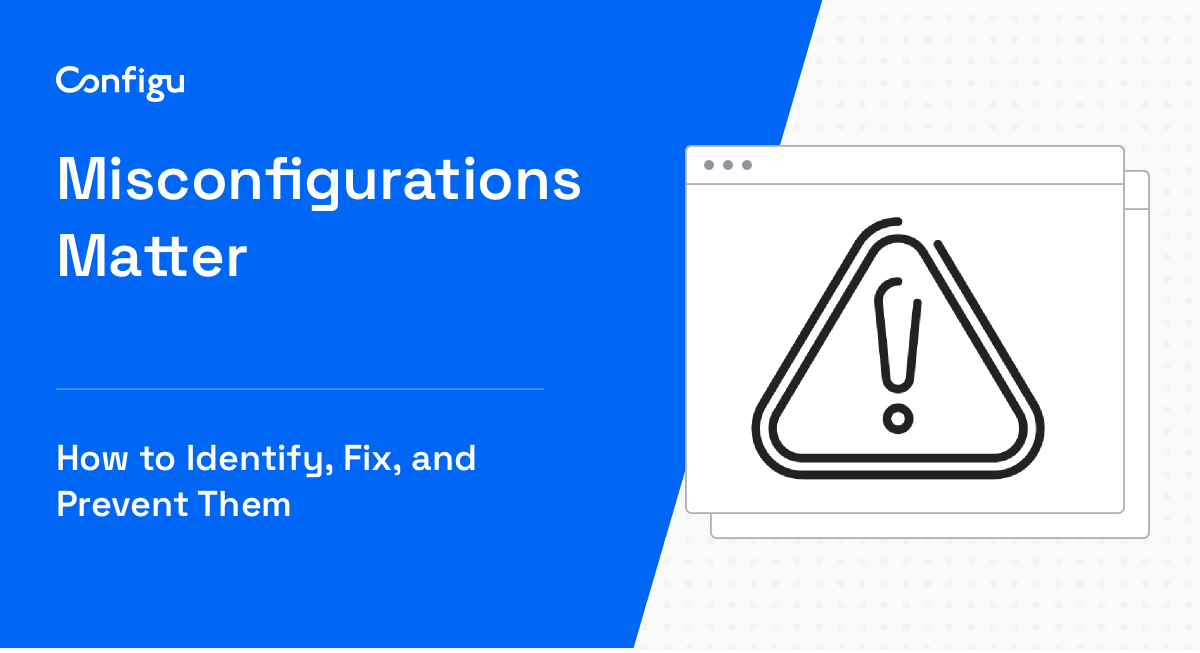What Is a Misconfiguration?
A misconfiguration is an element in a system or application that is not configured correctly. Misconfigurations could be the result of hurried deployments, lack of expertise, or simple oversight. Regardless of the reason, they pose a substantial risk to the functionality and security of your critical systems.
The complexity of the modern IT landscape, with thousands of infrastructure elements, services, and applications, makes it more prone to misconfiguration. It is crucial to regularly audit configurations across your environment and fix any discovered issues promptly.
This is part of a series of articles about configuration management.
In this article:
Impact of Misconfigurations
Functional Impacts
Misconfigurations can affect the functionality of a system, and in some cases disrupt operations. For example, incorrectly configured databases may result in performance issues, while improper file and directory permissions can restrict access to legitimate users. Similarly, insecure cloud storage permissions can lead to data loss or corruption. In extreme cases, misconfigurations can also result in downtime to critical systems.
For businesses, these impacts can lead to loss of productivity (for internal systems) or a poor user experience (or customer facing systems). Hence, it is vital to ensure that your system is correctly configured to maintain smooth operations.
Security Vulnerabilities
Misconfigurations can inadvertently create security vulnerabilities, providing an open door for cyber threats. Even a small oversight can lead to data breaches, giving attackers access to sensitive data.
For instance, leaving default configurations unchanged or keeping unnecessary services and ports open can expose your system to potential attackers. Failing to define authentication or authorization for sensitive systems can allow attackers to gain unauthorized access and escalate privileges.
The risk associated with security vulnerabilities is not just about data loss. It extends to integrity and availability of your systems. Attackers can exploit these vulnerabilities to manipulate data, disrupt services, and even entirely compromise critical systems. It is crucial to identify and rectify misconfigurations to prevent these vulnerabilities.
Financial and Reputational Repercussions
The financial and reputational repercussions of misconfigurations can be severe. Data breaches resulting from security vulnerabilities can lead to hefty fines, especially with stringent data protection regulations like the General Data Protection Regulation (GDPR) in place. Moreover, the cost of remediation and recovery from a security incident can also be substantial.
Aside from the financial aspect, the reputational damage can be equally devastating. Customers and partners may lose trust in your ability to secure their data, leading to lost business opportunities.
Common Types of Misconfiguration
It is impossible to list all possible misconfigurations, but here are a few common types you are likely to experience.
Default Configurations Left Unchanged
One of the most common types of misconfiguration is leaving the default settings unchanged. Manufacturers often ship software and hardware with default settings to ease installation and setup. However, these default configurations are usually not secure and are widely known, making them a prime target for attackers.
Unnecessary Services and Ports Left Open
Another common misconfiguration is leaving unnecessary services and ports open. These services and ports are the gateways to your system, and leaving them open is like inviting attackers into your system. It is essential to close all unnecessary services and ports and secure the ones that need to remain open.
Improper File and Directory Permissions
Improper file and directory permissions is another type of misconfiguration that can lead to security vulnerabilities. Setting lax permissions can allow unauthorized users to access, modify, or delete critical files and directories. Overly restrictive permissions can block access to legitimate users. Therefore, it is important to set appropriate permissions for all files and directories in your system.
Incorrectly Configured Databases
Misconfiguring databases can lead to a host of problems, including data loss, performance issues, and security vulnerabilities. For instance, failing to turn on caching in a database could significantly impact performance for repeat queries.
Insecure Cloud Storage Permissions
Insecure cloud storage permissions is a type of misconfiguration that has been on the rise with the increased adoption of cloud services. Misconfigured cloud storage can lead to unauthorized access and data loss. It is crucial to secure your cloud storage with robust permissions and access controls.
Lack of Encryption Where Needed
Lack of encryption where needed is a common misconfiguration that can expose sensitive data to potential attackers. Encryption is a critical security measure that protects data in transit and at rest. Failing to implement encryption can result in accidental exposure of data, and in severe cases, catastrophic data breaches.
4 Ways to Identify Misconfigurations
Because misconfigurations can cause significant damage, it is critical to identify them as early as possible. Here are a few ways organizations can catch misconfigurations early:
1. Regular System and Network Audits
System and network audits involve thorough checks of your hardware, software, and network settings to ensure that they adhere to the established security policies. Regular audits will help you detect any changes that have been made to critical files, unauthorized access, or any other deviations that may compromise your system’s security.
Use a systematic approach to these audits, including a comprehensive checklist of all elements to be examined and a timeline for when these audits should occur.
2. Vulnerability Assessment Tools
Vulnerability assessment tools are designed to assess your system and identify any vulnerabilities, including those arising from misconfiguration. They conduct an in-depth evaluation of your systems, checking for weaknesses in your hardware, network, or applications. These tools offer detailed reports outlining the identified vulnerabilities, their severity, and recommendations on how to fix them.
3. Security Benchmarks and Compliance Checks
Another effective strategy to identify misconfigurations involves using security benchmarks and conducting compliance checks. Security benchmarks are guidelines and standards that outline the best practices for securing systems and networks. By comparing your system’s settings with these benchmarks, you can easily spot any deviations, including misconfigurations.
Compliance checks take a similar approach, ensuring that your system adheres to the required regulatory standards. There are many automated tools available that can check your systems against benchmarks and compliance guidelines.
4. Log Monitoring and Analysis
Finally, log monitoring and analysis is a critical component in identifying misconfigurations. Logs provide a wealth of information about your system’s operations, including changes made to settings, access attempts, and unusual behavior.
By monitoring and analyzing these logs, you can identify any unusual activities that may indicate misconfiguration. It’s advisable to use log management tools that can automate this process and alert you in real-time when suspicious activities occur.
Best Practices to Prevent Misconfiguration
Conduct Regular Security Reviews and Audits
While identifying misconfigurations is essential, prevention is always better than cure. Regular security reviews and audits are crucial in this regard. These reviews should not only focus on your hardware and software but also on your policies and procedures.
Ensure that your security policies are up-to-date and align with the best practices. Regular audits ensure that these policies are being adhered to, thereby preventing any potential misconfigurations.
Implement a Configuration Management Database
Another effective way to prevent misconfiguration is by implementing a Configuration Management Database (CMDB). A CMDB is a repository that tracks and manages all the configurations within your IT environment. It provides a clear picture of your IT assets, their configurations, and their relationships.
By having a centralized CMDB, you can easily manage the configurations and prevent any unauthorized changes, thereby reducing the risk of misconfiguration.
Employing Configuration Management Tools
Configuration management tools can also help prevent misconfiguration. These tools automate the process of managing system configurations, making it easier to control and enforce the desired configurations. They also enable you to track changes, detect discrepancies, and correct them before they pose a security risk.
Documenting All Configuration Changes
Documentation is a crucial aspect of preventing misconfiguration. Every change made to your system’s configuration should be documented, including the reason for the change, the person who made it, and its impact.
This documentation serves as a reference point in case of any issues and helps in tracking unauthorized changes. It also promotes accountability and ensures that changes are only made by authorized personnel.
CMDBs and configuration management tools can help provide an audit trail of changes to configurations, which serve as a type of documentation in large environments.
Invest in Training and Awareness
Human error is a significant cause of misconfiguration. Therefore, it’s essential to have training and awareness programs for your staff.
These programs should educate your team about the importance of proper configuration and the risks associated with misconfiguration. They should also train personnel on how to properly configure systems and how to identify and report potential misconfigurations. Regular refresher courses should also be conducted to keep your team updated on the latest best practices and common misconfigurations in new systems and applications.
Related content: Read our guide to configuration management software
Preventing Misconfiguration with Configu
Some configuration management software can help prevent misconfigurations. You should consider Configu, a configuration management platform comprised of two main components, the stand-alone Orchestrator, which is open source, and the Cloud, which is a SaaS solution:
Configu Orchestrator
As applications become more dynamic and distributed in microservices architectures, configurations are getting more fragmented. They are saved as raw text that is spread across multiple stores, databases, files, git repositories, and third-party tools (a typical company will have five to ten different stores).
The Configu Orchestrator, which is open-source software, is a powerful standalone tool designed to address this challenge by providing configuration orchestration along with Configuration-as-Code (CaC) approach.
Configu Cloud
Configu Cloud is the most innovative store purpose-built for configurations, including environment variables, secrets, and feature flags. It is built based on the Configu configuration-as-code (CaC) approach and can model configurations and wrap them with unique layers, providing collaboration capabilities, visibility into configuration workflows, and security and compliance standardization.
Unlike legacy tools, which treat configurations as unstructured data or key-value pairs, Configu is leading the way with a Configuration-as-Code approach. By modeling configurations, they are treated as first-class citizens in the developers’ code. This makes our solution more robust and reliable and also enables Configu to provide more capabilities, such as visualization, a testing framework, and security abilities.



